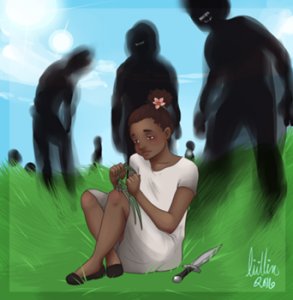 My interpretation of the cover art and blurb weren’t too far off for this short to medium length parser-based game. There isn’t too much I can say without entering spoiler territory, but I will remark on the long list of extensions employed in the game, including some written by the author. Some relate to the game’s most visible design element, a graphic pane for a game map, but most provide subtle functionality that gives the game a polite, polished feel.
My interpretation of the cover art and blurb weren’t too far off for this short to medium length parser-based game. There isn’t too much I can say without entering spoiler territory, but I will remark on the long list of extensions employed in the game, including some written by the author. Some relate to the game’s most visible design element, a graphic pane for a game map, but most provide subtle functionality that gives the game a polite, polished feel.
Integrating graphics into an Inform game is not trivial, even with the extensions. Last year, I started looking into various options for graphics and found that a lot of the libraries that worked with earlier versions of Inform no longer worked with the most recent release, and that some were not being maintained. Compared to past years, I found multiple versions of some extensions and spent quite a while digging through revision histories and figuring out compatibilities, dependencies, etc., so I appreciate the effort that this author went through. The map in the game works well even when the interpreter windows is smushed, stretched, minimized, etc., and it updates smoothly when the characters change locations.
[Some spoilers follow beyond this point]
I spent the first few turns in grab-everything mode, while I tried to figure out how to put the main character’s prescient ability to work. At some point, it clicked, and I realized what I was supposed to do. It is a clever set up and lends itself to interactive puzzles. Breaking it down to mechanism, it doesn’t sound as cool as it plays out in game terms: the main character can take actions and will immediately see how those actions influence future events. It’s a short heuristic feedback loop.
Most of the story is hinted at rather than stated — a good demonstration of show rather than say. We don’t know who all the actors are or the bigger context of the story, but we do know our goal: protect Kayla, and our constraint: get it done before the sun gets too high in the sky. Since the player doesn’t know when the foretold events will happen, there is a strong sense of time pressure early in the game. After a while, it becomes clear that the player has enough time to explore and try things, and the sense of pressure fades a bit, which gives the player a chance to think things through a bit more clearly.
I figured out most but not all of the actions to be taken; for the last bit, I looked into the walkthrough. There is a built in hint system, but I found that it told me nothing I didn’t already know. A smarter hint system that considers goals accomplished versus remaining or that is tied to object or location would give players a better chance of completing the story without recourse to the walkthrough. Still, I thought the solutions were clever and for the most part fair.
If I understand correctly, the number of solutions is just about the number required for a successful ending. I would suggest that there be some “slack”, i.e., that the number of solutions required for success would be less than number possible.
I was surprised when I reached the end. I thought that revealing success immediately was a missed opportunity. I might have required that the player commit to their final decisions by entering the obelisk — that might raise the stakes just a bit and make the ending more dramatic.
Evaluation
Story: 7
Voice: 8
Play: 8
Polish: 8
Technical: 8
JNSQ: 0
Preliminary Score: 7.8
Transcript: futureThreadsScript
